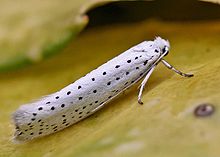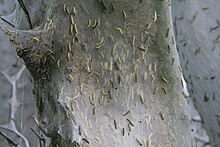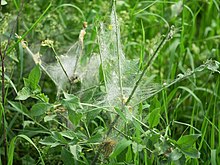- Certain members of the unrelated snout moths (Pyralidae) are also known as "ermine moths." Spilosoma lubricipeda is an unrelated moth with the common name "white ermine."
| Ermine moth | |
|---|---|

| |
| Yponomeuta evonymella | |

| |
| Communal larval web | |
| Scientific classification | |
| Domain: | Eukaryota |
| Kingdom: | Animalia |
| Phylum: | Arthropoda |
| Class: | Insecta |
| Order: | Lepidoptera |
| Superfamily: | Yponomeutoidea |
| Family: | Yponomeutidae Stephens, 1829 |
| Diversity | |
| 600 species | |
The family Yponomeutidae are known as the ermine moths, with several hundred species, most of them in the tropics. The larvae tend to form communal webs,[1] and some are minor pests in agriculture, forestry, and horticulture. Adult moths are minor pollinators.
There are five or six subfamilies. Some authors also include the closely related Plutellidae as yet another subfamily:
Subfamilies[edit]
The following genera do not have assigned subfamilies available:
- Abacistis
- Acrataula
- Aemylurgis
- Aictis
- Amalthina
- Anaphantis
- Argyresthites
- Artenacia
- Balanoptica
- Betharga
- Buxeta
- Calamotis
- Callithrinca
- Caminophantis
- Chionaemopsis
- Citrinarchis
- Conchiophora
- Coptoproctis
- Cymonympha
- Dascia
- Diaphragmistis
- Entrichiria
- Epactosaris
- Epichthonodes
- Eriopyrrha
- Euarne
- Exanthica
- Exaulistis
- Hesperarcha
- Hierodryas
- Ilychytis
- Iriania
- Iridostoma
- Isotornis
- Ithutomus
- Metanomeuta
- Metharmostis
- Mnemoses
- Mychonoa
- Nematobola
- Nosymna
- Orencostoma
- Oridryas
- Orinympha
- Orthosaris
- Palaetheta
- Parazelota
- Parexaula
- Pauridioneura
- Phasmatographa
- Piestoceros
- Podiasa
- Porphyrocrates
- Pronomeuta
- Protonoma
- Pseudorinympha
- Thyridectis
- Toiana
- Trisophista
- Typhogenes
Characteristics[edit]

Ermine moths are small to medium-sized moths varying in wingspan from 8 to 31 mm (0.3 to 1.2 in). The heads mostly have smooth scales, the haustellum is naked and the labial palps are curved upwards. The maxillary palps usually consist of one or two segments. The wings are long, often with fringes on the trailing edges of the hindwings. The colour is usually white, pale grey or drab, often with many dark speckles.[2]
Adult ermine moths are mostly nocturnal.
The larvae are leaf-webbers, leaf skeletonizers, leafminers or needleminers and are found on a variety of host plants. Some cause economic damage to crops and trees.[2]
Species (selection)[edit]
Better-known species include:
- Spindle ermine, Yponomeuta cagnagella
- Bird-cherry ermine, Yponomeuta evonymella
- Orchard ermine, Yponomeuta padella
- Yponomeuta plumbella
- Acmosara polyxena
- Apple ermine Yponomeuta malinellus
- Ailanthus webworm
Etymology[edit]
The word Yponomeutidae comes from the Ancient Greek ὑπό (ypo) meaning under and νομός (nomós) meaning food or dwelling, thus "feeding secretly, or burrow".[3]
References[edit]
- ^ James, David G. (2017). The Book of Caterpillars: A Life-Size Guide to Six Hundred Species from Around the World. University of Chicago Press. p. 288. ISBN 978-0-226-28736-2.
- ^ a b Capinera, John L. (2008). Encyclopedia of Entomology. Springer Science & Business Media. pp. 1360–1361. ISBN 978-1-4020-6242-1.
- ^ Westwood, J. O. (October 1837). Loudon, John Claudius (ed.). "A series of Articles on the Insects most Injurious to Cultivators -- No. 8. The small Ermine Moth". The Gardener's Magazine and Register of Rural and Domestic Improvement. 13: 434.
External links[edit]
- "Alien invasions, horror stories, or just the Ermine moth?". Natural History Museum. 17 June 2010. Archived from the original on 8 January 2011.